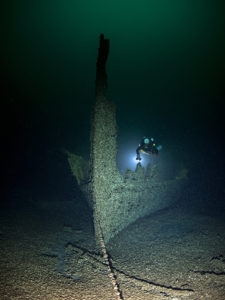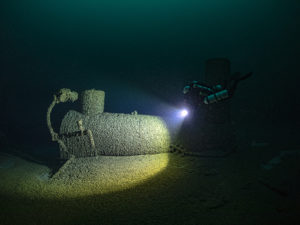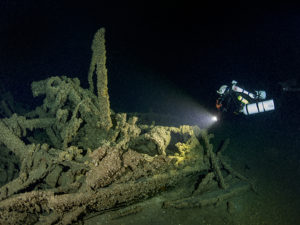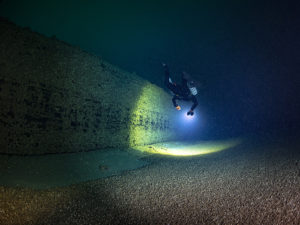 The Canadian steamship Homer Warren has been sitting on the bottom of Lake Ontario for nearly one hundred years. In 2003, shipwreck enthusiasts Jim Kennard and Dan Scoville located the wrecked remains using side scan sonar equipment, but it was careful research that led them to the right location. Using newspaper accounts, witness reports and weather data, they pieced together a hypothesis about where the ship came to rest. To confirm the find, Dan Scoville made solo dives to document the wreck with his video camera. Now fifteen years later, Jill Heinerth and Teddy Garlock have brought back the first photos of the wreck site. The Homer Warren rests well beyond the range of recreational diving in near-freezing water. Heinerth and Garlock used rebreathers and exotic helium mixes to complete their dive and the lengthy decompression hang.
The Canadian steamship Homer Warren has been sitting on the bottom of Lake Ontario for nearly one hundred years. In 2003, shipwreck enthusiasts Jim Kennard and Dan Scoville located the wrecked remains using side scan sonar equipment, but it was careful research that led them to the right location. Using newspaper accounts, witness reports and weather data, they pieced together a hypothesis about where the ship came to rest. To confirm the find, Dan Scoville made solo dives to document the wreck with his video camera. Now fifteen years later, Jill Heinerth and Teddy Garlock have brought back the first photos of the wreck site. The Homer Warren rests well beyond the range of recreational diving in near-freezing water. Heinerth and Garlock used rebreathers and exotic helium mixes to complete their dive and the lengthy decompression hang.
Although the cabins are missing, reportedly washing up on shore at the time fo the sinking, the rest of the wreck sits upright. The bow stem post rises up nearly 30 feet, giving the appearance of a Viking ship. The stern of the vessel is badly damaged and partly buried leading the divers to believe that she struck the bottom stern first.
The 178-foot-long Homer Warren was the oldest wooden straight-deck bulk freighter in operation on the Great Lakes. She was traveling from Oswego, New York, to Toronto, Canada, with a crew of nine men, all of whom were lost in one of the worst storms in the previous 25 years. With winds blowing over 60 knots, a local fisherman near Pultneyville, New York recalled seeing the ship’s decks awash and waves breaking over the entire vessel. It was the last anyone would see of the ship until parts of the pilothouse and cabins washed ashore with a badly damaged lifeboat. Bodies of four of the nine crewmen also washed ashore, wearing lifejackets.
 There are still some mysteries that surround the demise of the Homer Warren. It was believed she was carrying a cargo of coal, but Scoville’s first dive returned with evidence that at least part of the cargo was corn. Kennard reports, “When dried corn is exposed to heavy moisture it can expand up to 100% of its original size. If the Homer Warren’s hatches were unsecured, allowing water to enter the cargo hold, the corn would have absorbed water and swelled. The expanding corn would have put pressure on the sides of the old steamship, weakening it to the point where it finally opened up allowing the lake water to rush in, taking the ship to the bottom.”
There are still some mysteries that surround the demise of the Homer Warren. It was believed she was carrying a cargo of coal, but Scoville’s first dive returned with evidence that at least part of the cargo was corn. Kennard reports, “When dried corn is exposed to heavy moisture it can expand up to 100% of its original size. If the Homer Warren’s hatches were unsecured, allowing water to enter the cargo hold, the corn would have absorbed water and swelled. The expanding corn would have put pressure on the sides of the old steamship, weakening it to the point where it finally opened up allowing the lake water to rush in, taking the ship to the bottom.”
